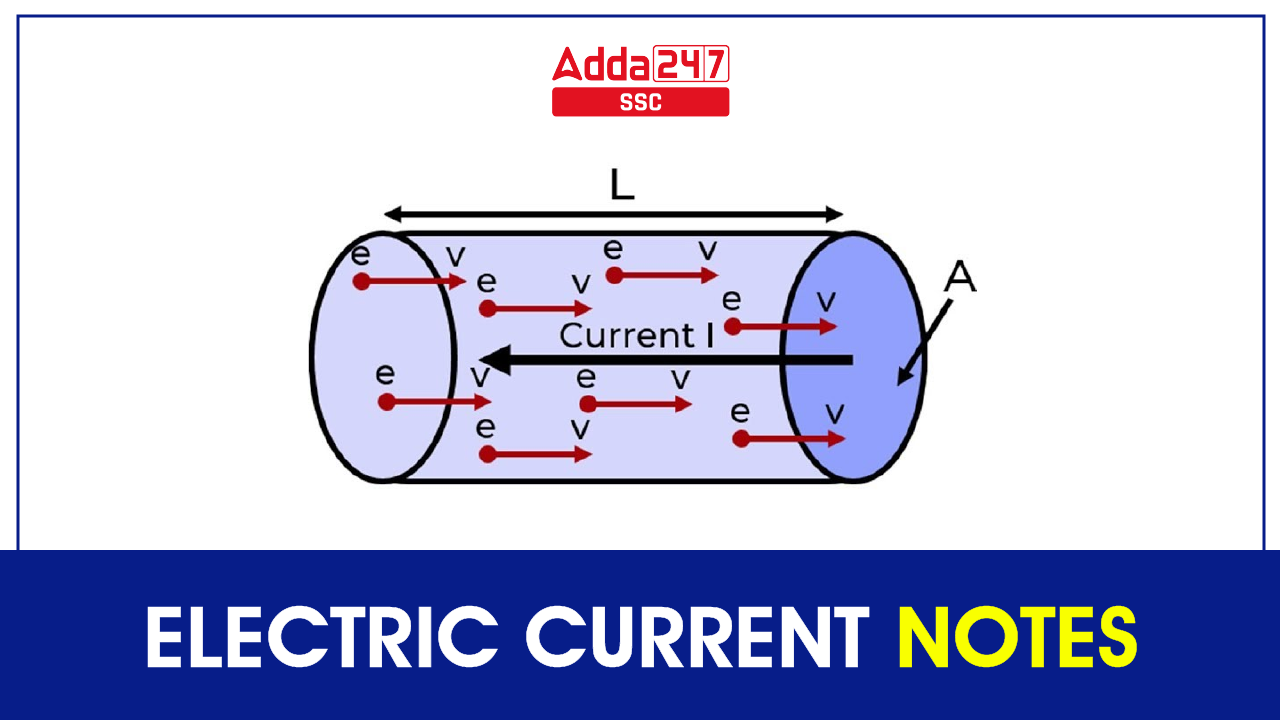General Science is one of the most important sections with respect to all Government Job Exams which can help a candidate in scoring maximum marks in a competitive exam in the least amount of time. In this context, we are offering crucial notes pertaining to Physics, which include comprehensive explanations of definitions, concepts, laws, formulae, rules, and properties. These notes are particularly useful from an exam perspective and can aid candidates in maximizing their marks.
In the subject of physics, electric current is one of the most important topics. It contains many definitions, formulas and applications that can form the basis of questions asked in various competitive examinations. Electric current is closely related to the concept of magnetism. Given below are some points related to this topic.
Electric Current
Electric current is expressed by the amount of charge flowing through a particular area in unit time. It is the rate of flow of electric charges. If a net charge Q, flows across any cross-section of a conductor in time t, then the current I, through the cross-section is-
I = Q/t
The SI unit of electric charge is the coulomb (C), which is equivalent to the charge contained in nearly: 6 ✖ 10¹⁸ electrons
The electric current is expressed by a unit called ampere (A). One ampere is constituted by the flow of one coulomb of charge per second, that is, 1A = 1C/1s.
EXAMPLE: A current of 0.5 A is drawn by a filament of an electric bulb for 10 minutes. Find the amount of electric charge that flows through the circuit.
Solution:
We are given, I = 0.5 A; t = 10 min = 600 s.
As Q = It
= 0.5 A × 600 s
= 300 C
Electric Potential And Potential Difference
The electric potential difference between two points in an electric circuit carrying some current is the work done to move a unit charge from one point to the other
Potential difference (V) between two points = Work done (W)/Charge (Q)
V = W/Q
The SI unit of electric potential difference is volt (V), named after Alessandro Volta (1745–1827), an Italian physicist. One volt is the potential difference between two points in a current-carrying conductor when 1 joule of work is done to move a charge of 1 coulomb from one point to the other.
The potential difference is measured by means of an instrument called the voltmeter. The voltmeter is always connected in parallel across the points between which the potential difference is to be measured.
Electric Currents In Conductors
In other materials, notably metals, some of the electrons are practically free to move within the bulk material. These materials, generally called conductors, develop electric currents in them when an electric field is applied.
In solid conductors:
- When no electric field is present- The number of electrons traveling in any direction will be equal to the number of electrons traveling in the opposite direction. So, there will be no net electric current.
- If an electric field is applied- An electric field will be created and is directed from the positive towards the negative charge. They will thus move to neutralize the charges. The electrons, as long as they are moving, will constitute an electric current.
OHM’S LAW
Imagine a conductor through which current I is flowing and let V be the potential difference between the ends of the conductor. Ohm’s law states that:
V ∝ I
or, V = R I;
where the constant of proportionality R is called the resistance of the conductor. The SI units of resistance is ohm, and is denoted by the symbol Ω.
The resistance of the conductor depends on-
- its length,
- its area of cross-section, and
- the nature of its material.
Limitations Of OHM’S Law
- V ceases to be proportional to I
- The relation between V and I depends on the sign of V. In other words, if I is the current for a certain V, then reversing the direction of V keeping its magnitude fixed, does not produce a current of the same magnitude as I in the opposite direction
- The relation between V and I is not unique, i.e., there is more than one value of V for the same current I A material exhibiting such behavior is GaAs.
Resistivity
The resistance of a uniform metallic conductor is directly proportional to its length (l) and inversely proportional to the area of cross-section (A). That is,
R ∝ l and
R ∝ 1/A
Combining both, we get
R ∝ l/A
or, R = ρl/A
where ρ (rho) is a constant of proportionality and is called the electrical resistivity of the material of the conductor. The SI unit of resistivity is Ω m. It is a characteristic property of the material.
Resistivity Of Various Materials
- The resistivity of a material is found to be dependent on the temperature.
- The resistivity of an alloy is generally higher than that of its constituent metals. Alloys do not oxidize (burn) readily at high temperatures. For this reason, they are commonly used in electrical heating devices, like electric iron, toasters, etc. Tungsten is used almost exclusively for filaments of electric bulbs, whereas copper and aluminum are generally used for electrical transmission lines.
- Some materials like Nichrome (which is an alloy of nickel, iron, and chromium) exhibit a very weak dependence of resistivity with temperature.
- In contrast to metals, semiconductors experience a decrease in resistivity as temperature rises.
Two Major Types Of Resistors:
- Wire-wound resistors: These resistors are created by winding wires made of alloys such as manganin, constantan, nichrome, or similar materials. The selection of these alloys is primarily based on their resistance to changes in temperature. Wire-wound resistors typically have resistance values ranging from fractions of an ohm to a few hundred ohms.
- Carbon resistors: Resistors with higher resistance values are often manufactured using carbon. Carbon resistors are compact, cost-effective, and widely utilized in electronic circuits. Due to their small size, the resistance values of carbon resistors are represented using a color code system.
Relation Of Current And Drift Velocity
- When an electric field is applied, inside the conductor due to electric force the path of an electron, in general, becomes curved (parabolic) instead of straight lines, and electrons drift opposite to the field figure (B).
- Due to this drift, the random motion of electrons gets modified and there is a net transfer of electrons across a cross-section resulting in current.
- Drift velocity is the average uniform velocity acquired by free electrons inside a metal by the application of an electric field which is responsible for current through it.
Electrical Energy And Power
The rate at which electric energy is dissipated or consumed in an electric circuit is termed as electric power. The power P is given by
P = VI
Or P = I²R = V²/R
The SI unit of electric power is the watt (W). It is the power consumed by a device that carries 1 A of current when operated at a potential difference of 1 V. Thus,
1 W = 1 volt × 1 ampere = 1 V A
The commercial unit of electric energy is kilowatt-hour (kW h), commonly known as ‘unit’.
Cells In Series And Parallel
Cell: A cell is a device that generates electricity by using chemical energy. A cell has two electrodes, called the positive (P) and the negative (N), immersed in an electrolytic solution where the electrodes exchange charges with the electrolyte.
Note:-
- Current flows from the cathode to the anode through an external circuit.
- Current flows from the anode to the cathode through the electrolyte.
EMF (Electromotive force): It is defined as the potential difference between electrodes when there is no current in the cell. Emf of the cell initiates the flow of current in the cell.
Internal Resistance: It is the resistance offered by the electrolyte and electrodes when the current flows. It is denoted by ‘r’
Cells in Series
- When multiple cells are arranged in such a way that the positive terminal of one cell is connected to the negative terminal of the other cell and so on, it is known to be in series combination.
- For two cells of emf’s E1 and E2 connected in series with r1, r2 as their internal resistances, the formula is given as:
E equivalent = E1 + E2
r equivalent = r1 + r2
The rule for cells arranged in series combination:
- The equivalent emf of a series combination of n cells is just the sum of their individual emf’s, and
- The equivalent internal resistance of a series combination of n cells is just the sum of their internal resistances.
Cells in Parallel
- When cells are arranged in such a way that the positive terminals of all the cells are connected together and all the negative terminals are connected together, it is known to be in parallel combination.
- For two cells of emf’s E1 and E2 connected in parallel with r1, r2 as their internal resistances, the formula is given as:
1/r equivalent = 1/r₁ + 1/r₂
E equivalent/ r eq = E₁/r₁ + E₂/r₂
Important Note:-
- Cells are arranged in series to increase the voltage.
- Cells are increased in parallel to increase the current.
Potentiometer
- It is basically a long piece of uniform wire, sometimes a few meters in length across which a standard cell is connected.
- A current I flows through the wire which can be varied by a variable resistance (rheostat, R) in the circuit. Since the wire is uniform, the potential difference between A and any point at a distance l from A is
E(l) = ⌽l
where ⌽ is the potential drop per unit length. An application of the potentiometer is to compare the emf of two cells of emf ε1 and ε2 which is given by the equation:
E1/E2 = l1/l2 - The potentiometer has the advantage that it draws no current from the voltage source being measured.
- A potentiometer is also used to measure the internal resistance of a cell.
Conductor:
- A substance that allows the passage of electric charges through it easily is called a conductor. A conductor offers very low resistance to the flow of current. For example copper, silver, aluminum etc.
Insulator
- A substance that has infinitely high resistance does not allow electric current to flow through it. It is called an insulator. For example rubber, glass, plastic, Ebonite etc.
Coulomb’s Law:
- Coulomb’s Law refers to the fundamental law of electrostatics that describes the interaction between electric charges. It states that the force between two point charges is directly proportional to the product of their magnitudes and inversely proportional to the square of the distance between them. Mathematically, Coulomb’s Law can be expressed as:F = k * (q1 * q2) / r^2
Candidates can refer to the points above to score well in the general science section of various exams. We will be posting more notes like this for the reference of the candidates to help them boost their performance even further.



 Upcoming Government Exams, Complete Govt...
Upcoming Government Exams, Complete Govt...
 SSC Exam Calendar 2025–26 Out, Check All...
SSC Exam Calendar 2025–26 Out, Check All...
 RRB JE 2024 Notification, CBT 2 Exam Dat...
RRB JE 2024 Notification, CBT 2 Exam Dat...


